 The mammoth , a fossil mammal close to elephants, the last representatives of which died out a few thousand years ago, is depicted in many prehistoric cave paintings. Some peoples became intimately linked to a particular animal from which they derived most of their sustenance, which inspired their art and deeply permeated their spirituality. We have thus spoken of the civilization of the bison for the Amerindians or of the civilization of the reindeer for the Lapps. What about the prehistoric people who made the mammoth a key animal in the bestiary of parietal art?
The mammoth , a fossil mammal close to elephants, the last representatives of which died out a few thousand years ago, is depicted in many prehistoric cave paintings. Some peoples became intimately linked to a particular animal from which they derived most of their sustenance, which inspired their art and deeply permeated their spirituality. We have thus spoken of the civilization of the bison for the Amerindians or of the civilization of the reindeer for the Lapps. What about the prehistoric people who made the mammoth a key animal in the bestiary of parietal art?
The Mammoth, Giant of the Ice Age
50 million years ago, in Africa, mammoths appeared. This large mammal, a cousin of the elephant but not its ancestor, belongs to the order of proboscideans (trunk bearers).
It consists of a bulky head but lightened by a skull composed of cavities filled with air. It supported a trunk weighing 100 kg and tusks reaching 4 meters in length. Its massive body could be 4 meters at the withers and weigh on average between 6 and 8 tons. The largest of all was the steppe mammoth (Mammuthus trogontheri ). It could reach 4.30 m and weighed at least 10 tons.
The mammoth grew throughout its life. It ate grasses and shrubs.
 His enormous molars allowed him to grind 200 kg of vegetables every day. Its diet is known thanks to the remains found in the stomach and intestine of frozen specimens. The dominant plants are herbaceous but shrubs are also present such as willow or birch.
His enormous molars allowed him to grind 200 kg of vegetables every day. Its diet is known thanks to the remains found in the stomach and intestine of frozen specimens. The dominant plants are herbaceous but shrubs are also present such as willow or birch.
Over time, mammoths have developed an important adaptation to cold. The most suitable species was the woolly mammoth (Mammuthus primigenius ) appeared 250,000 years ago. His body was covered with a 10 cm layer of fat, 2 cm thick skin and hair up to 1 meter in length. Its ears and tail, due to their small size, as well as its thick fur and anal flap, helped it to fight against heat loss.
Woolly mammoths probably lived like modern elephants, that is, in groups based on matriarchy. The oldest female led the group, made up of a few individuals. The adult males, on the contrary, led a solitary life and joined the females only during the rut.
Some mammoth species were adapted to temperate climates. Others had no fur such as the southern mammoth (Mammuthus mériodionalis ) which lived 2 million years ago in open forest regions of Eurasia and North America where the climate was relatively mild.
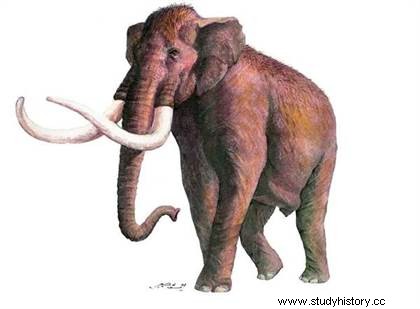
The image of the mammoth in large snowy expanses is only part of the reality. Their living environment was not the tundra, where only mosses, lichens and fungi grow, but a grassy steppe with a wide variety of plants. This cold steppe, which covered most of Eurasia and North America, is also called the “mammoth steppe”.
What role did the mammoth play in the life of man?
The presence of artifacts made from mammoth bones does not prove that they coexisted. The bones could very well have been found and worked on afterwards. On the other hand, we have representations of mammoths on the walls of certain caves (Rouffignac or Pech Merle, for example) and others carved, in ivory for example.
Neanderthal man and modern man lived alongside mammoths present in Europe between 200,000 and 30,000 years ago. For them, the mammoth was an inexhaustible source of raw materials. It was probably hunted occasionally, but more likely the object of scavenging. It was a significant food resource. Meat and marrow were used to feed (2 tons of consumable meat). The mammoth skeleton is made up of 215 bones of very different sizes and shapes. Its ivory tusks were used in the manufacture of ornaments, tools and weapons, but could also be a support for portable art or even be used in the construction of huts.
Indeed, archaeologists have found many archaeological sites in Ukraine with remains of mammoth bone huts. The use of these bones and tusks in the construction of the huts was to compensate for the lack of trees in the mammoth steppes consisting of grasses and scattered bushes.
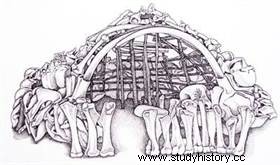
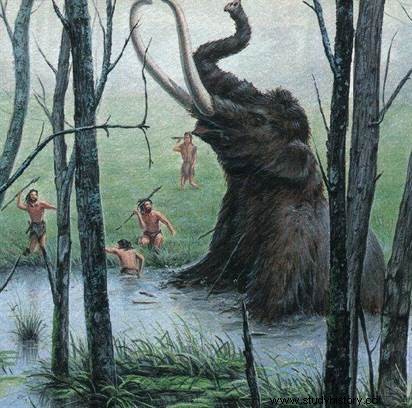
Still in Ukraine, we have another site that is very representative of the habitat. This is the Mezhirich deposit dated 15,000 years. It was calculated there that the total weight for the construction of a bone hut is 20 tons.
In Western Europe, we have not found mammoth bone huts.
Mammoth blubber was also used as fuel along with bones. The small molars could be elements of adornment, the larger ones, used to rasp the skins or as an anvil. The skins were used to cover huts, as blankets and perhaps as clothing.
The disappearance of the Mammoths
15,000 years ago in North America, global warming contributed to the disappearance of the mammoth steppe. A humid and less cold climate transforms this steppe into marshy tundra and coniferous forests. Mammoth molars are perfectly adapted for grazing grass but probably not for foliage. Some areas of steppes may have survived but must have been insufficient to support large populations of mammoths.
It is also possible that human hunting of depleted populations may have contributed to the disappearance of the woolly mammoth. But this is not yet proven by archaeological research. As seen previously, the few hunters had very little to attack the mammoths knowing that they had other species less dangerous and easier to hunt, such as the reindeer.

In 1993, the disappearance of the mammoth 10,000 years ago, in Europe, was controversial with a discovery. It is on the island of Wrangel, in the North-East of Siberia, that the paleontologist S.Vartanyan discovered fossils of a dwarf form of woolly mammoth dated 4000 years.
Can man, through his acts of hunting, or the change in climate and landscapes be sufficient to explain, in whole or in part, the disappearance of mammoths? The question remains.
The myth of the Mammoth
Adornments or objects such as Venus or animal sculptures in ivory are numerous in Paleolithic art, especially in the Upper Paleolithic (-35,000 to -12,500). Nevertheless, mammoths are never the majority in parietal art, with the exception of Rouffignac:out of 260 parietal representations, 160 are mammoths.
The vast majority of representations of mammoths that we have are precisely parietal representations (on cave walls). Different techniques are then used to represent them.
Design:
On the walls of the Pech Merle cave in the Lot (dated to 25,000 BP), we have 26 mammoths represented. The "black frieze" represents eleven mammoths, as well as aurochs, bison and a horse, all drawn with a black line, probably with manganese. This frieze occupies an alcove seven meters long and two meters high.
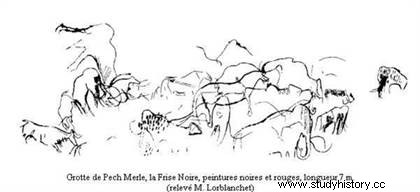
With 76 mammoths, the Chauvet cave is the second to have as many representations of this mammal, but they are also the oldest known in Western Europe. The Aurignacians are the authors. Among these works we have the representation of a mammoth forequarters, in concretions, drawn in red.
Finally, in the cave of Baume-Latrone in the Gard, an example of a stylized mammoth dating from the Upper Palaeolithic, traced in red clay. It has a very long trunk and tiny tusks.

Bas relief:
A bas-relief, unique in Palaeolithic art, was found in the Mammoth (or Saint-Front) cave in the Dordogne. It is a mammoth sculpture 1m30 high and alone on the limestone wall.

Engraving:
In Arcy-sur-Cure, in Yonne, the shape of the wall seemed predestined to the representation of a mammoth. Indeed, a prehistoric man used a natural hollow in the wall as well as the slight reliefs around it to engrave a mammoth head with the trunk raised. This way of using the shapes of the wall to engrave or draw animals can be found in other caves, notably that of Roc-aux-Sorciers in Vienne.The cave of Cussac in the Dordogne, attributed to the Gravettian, has 150 engravings, very little known because they are not open to the public. It reveals several mammoth engravings, including one depicting a woolly mammoth.
In Périgord, the cave of Jovelle offers us 6 other examples of engraved mammoths.
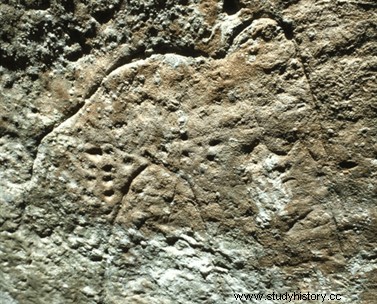
But we don't just have parietal representations. Portable art was also very widespread during prehistory. These transportable objects can be made of a large number of materials such as ivory, bone, terracotta, rock, etc. Many representations of mammoths have been found. The first specimen was discovered in 1864 in the cave of La Madeleine in the Dordogne:it was indisputable proof of the coexistence of the mammoth and man. We can also cite a terracotta mammoth dated to the Gravettian found at Pavlov in the Czech Republic.
So how to explain the over-representation of the parietal and movable parts of this little-hunted animal? It cannot be commemorations of hunts, moreover hunting scenes are extremely rare. We no longer think of hunting rites intended to influence fruitful future hunts either. We must certainly look more towards the natural charisma of this animal, the respect it imposes and perhaps a certain form of devotion, or even identification, relating to shamanic practices that the lack of sources does not always allow us. not to enter. In representations of prehistoric people, the boundary between human and animal is more than tenuous, as shown, among other things, by the mammoth man engraved on the walls of Combarelles or the man with the head of a feline (found in Hohlenstein, Germany ) carved… In mammoth ivory…

Discovery of a mammoth in France
Tuesday, November 6, 2012 was announced the great discovery made during the summer in Seine et Marne. Archaeologists excavating a Gallo-Roman site on the banks of the old bed of the Marne have discovered a mammoth skeleton almost whole. Great discovery for France because if we discovered a large number of scattered fragments, only three other skeletons had so far been discovered in 150 years.
 Another peculiarity of this one, it was discovered with two flakes of flint carved near the skull which suggests to researchers that he met Neanderthal man. Was it hunted and killed by man or did it die naturally and then skinned? This mammoth was nicknamed "Helmut" by researchers, it would be a young male of 20 to 30 years old who lived in France during the Ice Age more than 100,000 years ago. Another unanswered question to date, the presence of a humerus and a tusk belonging to another specimen were also discovered under this skeleton. Further, more in-depth studies of the skeletons should tell us more.
Another peculiarity of this one, it was discovered with two flakes of flint carved near the skull which suggests to researchers that he met Neanderthal man. Was it hunted and killed by man or did it die naturally and then skinned? This mammoth was nicknamed "Helmut" by researchers, it would be a young male of 20 to 30 years old who lived in France during the Ice Age more than 100,000 years ago. Another unanswered question to date, the presence of a humerus and a tusk belonging to another specimen were also discovered under this skeleton. Further, more in-depth studies of the skeletons should tell us more. Bibliography
- Duhard J.P., Realism of the paleolithic male image, Ed. J. Million, 1996.
- Mohen J.-P. and Taborin Y., Prehistoric Societies, Ed. Hachette Supérieur, 2005.
- Patou-Mathis M., Meat eaters:from prehistory to the present day, Ed. Perrin, 2009.
- Latreille F. and Buigues B., Mammoth , Ed. Robert Laffont, 2000.
- The Archaeological Files, Decorated Caves of France, n°324 Nov./Dec. 2007.
- Special edition Sciences et vie and Paris Match, La cave de la Combe d'Arc, 2004.
